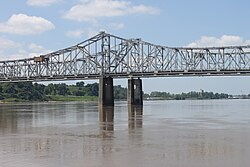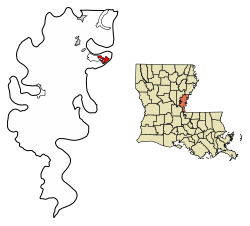Vidalia, Louisiana | |
|---|---|
| City of Vidalia | |
 | |
| Motto: City on the Move | |
 Location of Vidalia in Concordia Parish, Louisiana. | |
| Coordinates: 31°34′00″N91°26′26″W / 31.56667°N 91.44056°W [1] | |
| Country | |
| States | Louisiana |
| Parish | Concordia |
| Incorporated (town) | 1870 |
| Incorporated (city) | 2012 |
| Government | |
| • Type | Mayor-council government |
| • Body | City council |
| Area | |
• Total | 2.59 sq mi (6.72 km2) |
| • Land | 2.59 sq mi (6.72 km2) |
| • Water | 0.00 sq mi (0.00 km2) |
| Elevation | 59 ft (18 m) |
| Population (2020) | |
• Total | 4,027 |
| • Density | 1,552.43/sq mi (599.36/km2) |
| ZIP code | 71373 |
| FIPS code | 22-78470 |
| GNIS feature ID | 2406799 [1] |
| Website | cityofvidaliala |
Vidalia is the largest city in and the parish seat of Concordia Parish, Louisiana, United States. [3] The population was 4,299 as of the 2010 census. [4]
Contents
- History
- Geography
- Demographics
- 2020 census
- 2010 census
- Arts and culture
- Sites of interest
- References
- External links
Vidalia is located on the west bank of the Mississippi River.
The city of Natchez, Mississippi, lies on the opposite bank of the river, connected by the Natchez–Vidalia Bridge, carrying U.S. Routes 65, 84, and 425.


